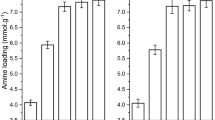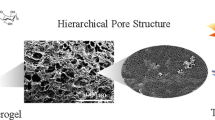Abstract
Nitrocellulose (NC) aerogel was prepared by sol–gel synthetic approach and supercritical carbon dioxide drying method as a new energetic matrix for nano-composite energetic materials. Scanning electron microscopy of the NC aerogel reveals that the aerogel is accumulated by nanoparticles with a diameter of 30–50 nm and has nano-porous structure, which makes the thermal behavior of the NC aerogel different from that of the NC fibers. Therefore, the thermal properties of NC aerogel were determined by TG/DSC, which showed that the maximum decomposition temperature and the exothermic peak temperature of NC aerogel decreased 8.2 and 11.4 °C than NC fibers, respectively. By TG/FTIR technology combined FTIR test of the condensed phase, the decomposition mechanism was derived based on the experimental results. The initial reaction of NC aerogel decomposition is the splitting of urethane bond, and then, the scission of –O–NO2 bonds happens. Moreover, the macromolecular chains’ scission site of NC aerogel firstly occurs at –C–O–C– in the ring, while the chains of NC fibers break at –C–O–C– between the rings.









Similar content being viewed by others
References
Tillotson TM, Hrubesh LW, Simpson RL, Lee RS, Swansiger RW, Simpson LR. Sol–gel processing of energetic materials. J Non Cryst Solids. 1998;225:358–63.
Tillotson TM, Gash AE, Simpson RL, Hrubesh LW, Satcher JH, Poco JF. Nanostructured energetic materials sing sol–gel methodologies. J Non Cryst Solids. 2001;285:338–45.
Gao K, Li G, Luo Y, et al. Preparation and characterization of the AP/Al/Fe2O3 ternary nano-thermites. J Therm Anal Calorim. 2014;118:43–9.
Comet M, Siegert B, Pichot V, et al. Reactive characterization of nanothermites. J Therm Anal Calorim. 2013;111:431–6.
Leventis N, Chandrasekaran N. Sadekar AG, One-pot synthesis of interpenetrating inorganic/organic networks of CuO/resorcinol-formaldehyde aerogels: nanostructured energetic materials. J Am Chem Soc. 2009;31:4576–7.
Chen R, Luo Y, Sun J, Li G. Preparation and properties of an AP/RDX/SiO2 nanocomposite energetic material by the sol–gel method. Propel Expl Pyrot. 2012;37:422–6.
Gash AE, Simpson RL, Satcher JH, Nanostructured energetic materials with sol–gel chemistry. LLNL. 2003; 201119.
Chen X, Song G, Sun J. Preparation of HMX–AP–SiO2 nano-composite energetic materials by sol–gel method. China Powder Sci Technol. 2012;18:47–54.
Nie F, Zhang J, Guo Q, Qiao Z, Zeng G. Sol–gel synthesis of nanocomposite crystalline HMX/AP coated by resorcinol–formaldehyde. J Phys Chem Solids. 2010;71:109–13.
Jin M, Luo Y. Preparation and characterization of RF/AP nano-composite energetic materials. Chin J Explos Propel. 2012;35:65–9.
Tappan BC, Brill TB. Thermal decomposition of energetic materials 85: cryogels of nanoscale hydrazinium diperchlorate in Resorcinol-Formaldehyde. Propel Expl Pyrot. 2003;28:72–6.
Wang X, Li J, Luo Y, Huang M. A novel ammonium perchlorate/graphene aerogel nanostructured energetic composite: preparation and thermal decomposition. Sci Adv Mater. 2014;6:530–7.
Osada H. Kayaku chemistry. Tokyo: Maruzen; 2003. p. 190–2.
Katoh K, Ito S, Kawaguchi S. Effect of heating rate on the thermal behavior of nitrocellulose. J Therm Anal Calorim. 2010;100:303–8.
Tappan BC, Brill TB. Thermal decomposition of energetic materials 85: cryogels of nanoscale hydrazinium diperchlorate in Resorcinol-Formaldehyde. Propel Expl Pyrot. 2003;28:72–6.
Li J, Brill TB. Nanostructured energetic composites of CL-20 and binders synthesized by sol–gel methods. Propel Expl Pyrot. 2006;31:61–9.
Tappan BC, Brill TB. Thermal decomposition of energetic materials 86. Cryogel synthesis of nanocrystalline CL-20 coated with cured nitrocellulose. Propel Expl Pyrot. 2003;28:223–30.
Jin M, Luo Y. Preparation and characterization of nitrocellulose aerogel. Chin J Explos Propel. 2013;36:82–6.
Sovizi MR, Hajimirsadeghi SS, Naderizadeh B. Effect of particle size on thermal decomposition of nitrocellulose. J Hazard Mater. 2009;168:1134–9.
Yoshitake N, Furukawa M. Thermal degradation mechanism of α, γ-diphenyl alkyl allophanate as a model polyurethane by pyrolysis-high-resolution gas chromatography/FT-IR. J Anal Appl Pyrol. 1995;33:269–81.
Berger B, Charsley EL, Warrington SB. Characterization of the zirconium/potassium perchlorate/nitrocellulose pyrotechnic system by simultaneous thermogravimetry–differential thermal analysis–mass spectrometry. Propel Expl Pyrotech. 1995;20:266–72.
Rychlý J, Lattuati-Derieux A, Matisová-Rychlá L, et al. Degradation of aged nitrocellulose investigated by thermal analysis and chemiluminescence. J Therm Anal Calorim. 2012;107:1267–76.
Makashir PS, Mahajan RR, Agrawal JJ. Studies on kinetics and mechanism of initial thermal decomposition of nitrocellulose. J Therm Anal Calorim. 1995;45:501–9.
Binke N, Rong L, Zhengquan Y, Yuan W, Rongzu YPH, Qingsen Y. Studies on the kinetics of the first order autocatalytic decomposition reaction of highly nitrated nitrocellulose. J Therm Anal Calorim. 1999;58:403–11.
Dauerman L, Tajima YA. Thermal decomposition and combustion of nitrocellulose. Aiaa J. 1968;6:1468–73.
Zeman S. New dependence of activation energies of nitroesters thermolysis and possibility of its application. Propel Expl Pyrot. 1992;17:17–9.
Levchik SV, Weil ED. Thermal decomposition, combustion and fire-retardancy of polyurethanes—a review of the recent literature. Polym Int. 2004;53:1585–610.
Author information
Authors and Affiliations
Corresponding authors
Rights and permissions
About this article
Cite this article
Jin, M., Luo, N., Li, G. et al. The thermal decomposition mechanism of nitrocellulose aerogel. J Therm Anal Calorim 121, 901–908 (2015). https://doi.org/10.1007/s10973-015-4574-4
Received:
Accepted:
Published:
Issue Date:
DOI: https://doi.org/10.1007/s10973-015-4574-4




